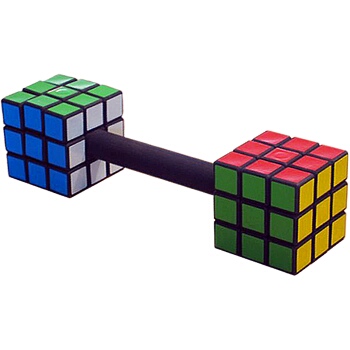|
Two 3x3x3s connected with a complex mechanism. Every turned side is followed by one side of the other cube.
Dumbbell Cube is a challenge for intellectual weight lifters. This puzzle consists of two Rubik's Cubes that are connected through an intricate gear system. If you turn a face on one cube, the identically coloured face at the other cube will follow. However, the connections between the two cubes have no symmetry. This makes solving this puzzle extremely difficult. A lot of work has gone into the design of the gear train. The connecting rod has seven layers in total. The inner layer connects the two spherical cores. The outer layer connects the two opposite white faces of the two cubes. The other five layers have gears to connect specific faces. For logistical reasons, I dyed the five sets of gears red, orange, yellow, green and blue, matching with the colours of the faces. This way, I could keep track which gear drives which face. The gears are so-called "double chevron gears", as invented by car maker Andre Citro�n. This gear design has the advantage that the gears do not slip sideways and that they can handle a lot of force. They also generate less noise than regular spur gears because of their continuous meshing. Oskar considered the first prototype (with the already choosen name "Barbell Cube") a failure because of to much friction. The Dumbbell Cube is more satisfying design. The number of permutations for this puzzle is halve of the square of the number for the Rubiks Cube: There are several other variants of the Dumbbell Cube thinkable. The concept rules that the directly opposite inner two faces have to move connected. All other connections can be designed freely. Contributors
Thank you to the following people for their assistance in helping collect the information on this page: Andreas Nortmann, Lawrence Cuthbert. Collections This puzzle can be found in collections of these members: Found a mistake or something missing? Edit it yourself or contact the moderator. |
|




